Related Research Articles

Lambert–Eaton myasthenic syndrome (LEMS) is a rare autoimmune disorder characterized by muscle weakness of the limbs.

Carpal tunnel syndrome (CTS) is a medical condition due to compression of the median nerve as it travels through the wrist at the carpal tunnel. The main symptoms are pain, numbness and tingling in the thumb, index finger, middle finger and the thumb side of the ring finger. Symptoms typically start gradually and during the night. Pain may extend up the arm. Weak grip strength may occur, and after a long period of time the muscles at the base of the thumb may waste away. In more than half of cases, both hands are affected.

De Quervain syndrome is inflammation of two tendons that control movement of the thumb and their tendon sheath. This results in pain at the outside of the wrist. Pain is typically increased with gripping or rotating the wrist. The thumb may also be difficult to move smoothly. Onset of symptoms is gradual.

Tenosynovitis is the inflammation of the fluid-filled sheath that surrounds a tendon, typically leading to joint pain, swelling, and stiffness. Tenosynovitis can be either infectious or noninfectious. Common clinical manifestations of noninfectious tenosynovitis include de Quervain tendinopathy and stenosing tenosynovitis
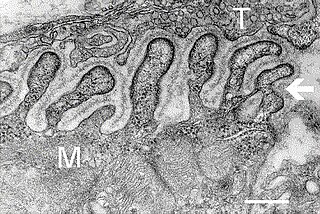
A neuromuscular junction is a chemical synapse between a motor neuron and a muscle fiber. It allows the motor neuron to transmit a signal to the muscle fiber, causing muscle contraction.

Osgood–Schlatter disease (OSD) is inflammation of the patellar ligament at the tibial tuberosity (apophysitis). It is characterized by a painful bump just below the knee that is worse with activity and better with rest. Episodes of pain typically last a few weeks to months. One or both knees may be affected and flares may recur.

Adie syndrome, also known as Holmes-Adie syndrome, is a neurological disorder characterized by a tonically dilated pupil that reacts slowly to light but shows a more definite response to accommodation. It is frequently seen in females with absent knee or ankle jerks and impaired sweating.
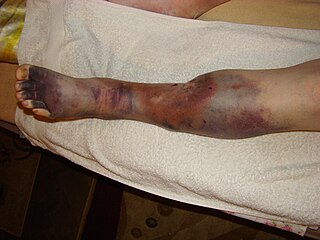
Post-thrombotic syndrome (PTS), also called postphlebitic syndrome and venous stress disorder is a medical condition that may occur as a long-term complication of deep vein thrombosis (DVT).
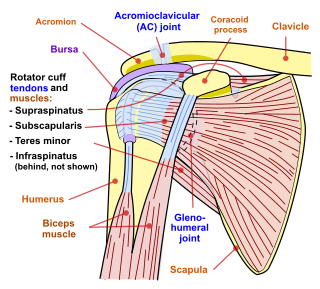
Subacromial bursitis is a condition caused by inflammation of the bursa that separates the superior surface of the supraspinatus tendon from the overlying coraco-acromial ligament, acromion, and coracoid and from the deep surface of the deltoid muscle. The subacromial bursa helps the motion of the supraspinatus tendon of the rotator cuff in activities such as overhead work.

Amifampridine is used as a drug, predominantly in the treatment of a number of rare muscle diseases. The free base form of the drug has been used to treat congenital myasthenic syndromes and Lambert–Eaton myasthenic syndrome (LEMS) through compassionate use programs since the 1990s and was recommended as a first line treatment for LEMS in 2006, using ad hoc forms of the drug, since there was no marketed form.
A paraneoplastic syndrome is a syndrome that is the consequence of cancer in the body, specifically due to the production of chemical signalling molecules by tumor cells or by an immune response against the tumor. Unlike a mass effect, it is not due to the local presence of cancer cells.
Congenital myasthenic syndrome (CMS) is an inherited neuromuscular disorder caused by defects of several types at the neuromuscular junction. The effects of the disease are similar to Lambert-Eaton Syndrome and myasthenia gravis, the difference being that CMS is not an autoimmune disorder. There are only 600 known family cases of this disorder and it is estimated that your chance of having it is 1 in 200,000.
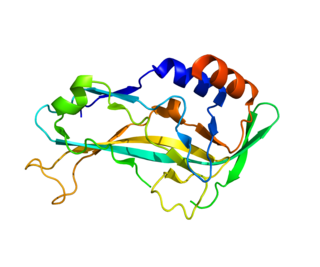
T-box transcription factor TBX5 is a protein that in humans is encoded by the TBX5 gene.
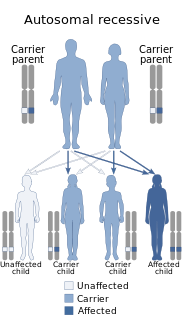
Marden–Walker syndrome (MWS) is a rare autosomal recessive congenital disorder. It is characterized by blepharophimosis, microcephaly, micrognathia, multiple joint contractures, arachnodactyly, camptodactyly, kyphoscoliosis and delayed motor development and is often associated with cystic dysplastic kidneys, dextrocardia, Dandy–Walker malformation and agenesis of corpus callosum.
Neuromuscular junction disease is a medical condition where the normal conduction through the neuromuscular junction fails to function correctly.

Shoulder impingement syndrome is a syndrome involving tendonitis of the rotator cuff muscles as they pass through the subacromial space, the passage beneath the acromion. It is particularly associated with tendonitis of the supraspinatus muscle. This can result in pain, weakness, and loss of movement at the shoulder.

Knee pain is pain in or around the knee.

Injuries to the arm, forearm or wrist area can lead to various nerve disorders. One such disorder is median nerve palsy. The median nerve controls the majority of the muscles in the forearm. It controls abduction of the thumb, flexion of hand at wrist, flexion of digital phalanx of the fingers, is the sensory nerve for the first three fingers, etc. Because of this major role of the median nerve, it is also called the eye of the hand. If the median nerve is damaged, the ability to abduct and oppose the thumb may be lost due to paralysis of the thenar muscles. Various other symptoms can occur which may be repaired through surgery and tendon transfers. Tendon transfers have been very successful in restoring motor function and improving functional outcomes in patients with median nerve palsy.

Carpal tunnel surgery, also called carpal tunnel release (CTR) and carpal tunnel decompression surgery, is a surgery in which the transverse carpal ligament is divided. It is a surgical treatment for carpal tunnel syndrome (CTS) and recommended when there is constant numbness, muscle weakness, or atrophy, and when night-splinting no longer controls intermittent symptoms of pain in the carpal tunnel. In general, milder cases can be controlled for months to years, but severe cases are unrelenting symptomatically and are likely to result in surgical treatment. Approximately 500,000 surgical procedures are performed each year, and the economic impact of this condition is estimated to exceed $2 billion annually.
Catalyst Pharmaceuticals is a biopharmaceutical company based in Coral Gables, Florida. The company is developing therapeutics for rare neurological diseases, including the phosphate salt of amifampridine for the treatment of Lambert–Eaton myasthenic syndrome (LEMS) under the trade name "Firdapse" which was approved by the United States Food and Drug Administration (FDA) for use in Adult LEMS patients on November 28, 2018 and commercially launched in January of 2019. On February 4, 2019, Bernie Sanders, United States Senator from Vermont, requested an explanation—including financial and non-financial information—from Catalyst that would justify Catalyst resetting Firdapse's list price at $375,000 a year. Prior to the FDA approval, patients were able to get an experimental version of the drug for free through compassionate use programs in accordance with FDA Rules and Guidelines.
References
- ↑ Jane M. Orient, Joseph D. Sapira. Sapira's art & science of bedside diagnosis, 3rd edition, page 610. Google books
- ↑ Doi, H; Murai Y; Kuroiwa Y (1978). "Deep tendon reflex in Eaton-Lambert syndrome". Folia Psychiatr Neurol Jpn. 32 (1): 109–13. doi:10.1111/j.1440-1819.1978.tb02784.x. PMID 207629. S2CID 7380547.
| This medical sign article is a stub. You can help Wikipedia by expanding it. |